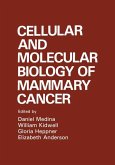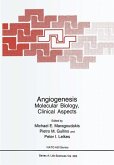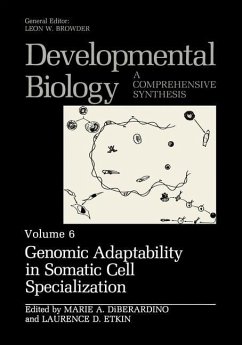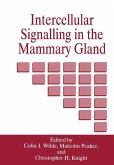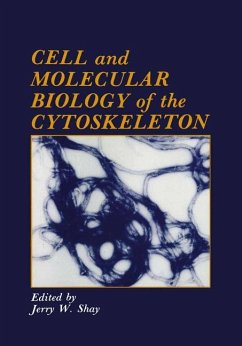The Cell Surface in Development and Cancer
Herausgegeben:Steinberg, Malcolm S.
The Cell Surface in Development and Cancer
Herausgegeben:Steinberg, Malcolm S.
- Broschiertes Buch
- Merkliste
- Auf die Merkliste
- Bewerten Bewerten
- Teilen
- Produkt teilen
- Produkterinnerung
- Produkterinnerung
This series was established to create comprehensive treatises on specific topics in developmental biology. Such volumes serve a useful role in developmental biology, since it is a very diverse field that receives contributions from a wide variety of disciplines. This series is a meeting-ground for the various practi tioners of this science, facilitating an integration of heterogeneous information on specific topics. Each volume is intended to provide the conceptual basis for a comprehen sive understanding of its topic as well as an analysis of the key experiments upon which that understanding…mehr
Andere Kunden interessierten sich auch für
![Cellular and Molecular Biology of Mammary Cancer Cellular and Molecular Biology of Mammary Cancer]() Cellular and Molecular Biology of Mammary Cancer37,99 €
Cellular and Molecular Biology of Mammary Cancer37,99 €![Angiogenesis Angiogenesis]() Angiogenesis147,99 €
Angiogenesis147,99 €![Genomic Adaptability in Somatic Cell Specialization Genomic Adaptability in Somatic Cell Specialization]() Genomic Adaptability in Somatic Cell Specialization42,99 €
Genomic Adaptability in Somatic Cell Specialization42,99 €![Intercellular Signalling in the Mammary Gland Intercellular Signalling in the Mammary Gland]() Intercellular Signalling in the Mammary Gland42,99 €
Intercellular Signalling in the Mammary Gland42,99 €![The Cell Cycle The Cell Cycle]() The Cell Cycle37,99 €
The Cell Cycle37,99 €![Cell and Molecular Biology of the Cytoskeleton Cell and Molecular Biology of the Cytoskeleton]() Cell and Molecular Biology of the Cytoskeleton83,99 €
Cell and Molecular Biology of the Cytoskeleton83,99 €![Development and Recognition of the Transformed Cell Development and Recognition of the Transformed Cell]() Development and Recognition of the Transformed Cell37,99 €
Development and Recognition of the Transformed Cell37,99 €-
-
-
This series was established to create comprehensive treatises on specific topics in developmental biology. Such volumes serve a useful role in developmental biology, since it is a very diverse field that receives contributions from a wide variety of disciplines. This series is a meeting-ground for the various practi tioners of this science, facilitating an integration of heterogeneous information on specific topics. Each volume is intended to provide the conceptual basis for a comprehen sive understanding of its topic as well as an analysis of the key experiments upon which that understanding is based. The specialist in any aspect of devel opmental biology should understand the experimental background of the field and be able to place that body of information in context to ascertain where additional research would be fruitful. At that point, the creative process gener ates new experiments. This series is intended to be a vital link in that ongoing process of learning and discovery
Hinweis: Dieser Artikel kann nur an eine deutsche Lieferadresse ausgeliefert werden.
Hinweis: Dieser Artikel kann nur an eine deutsche Lieferadresse ausgeliefert werden.
Produktdetails
- Produktdetails
- Developmental Biology 3
- Verlag: Springer / Springer US / Springer, Berlin
- Artikelnr. des Verlages: 978-1-4684-5052-1
- Softcover reprint of the original 1st ed. 1986
- Seitenzahl: 384
- Erscheinungstermin: 12. August 2013
- Englisch
- Abmessung: 254mm x 178mm x 21mm
- Gewicht: 721g
- ISBN-13: 9781468450521
- ISBN-10: 1468450522
- Artikelnr.: 39915323
- Herstellerkennzeichnung
- Books on Demand GmbH
- In de Tarpen 42
- 22848 Norderstedt
- info@bod.de
- 040 53433511
- Developmental Biology 3
- Verlag: Springer / Springer US / Springer, Berlin
- Artikelnr. des Verlages: 978-1-4684-5052-1
- Softcover reprint of the original 1st ed. 1986
- Seitenzahl: 384
- Erscheinungstermin: 12. August 2013
- Englisch
- Abmessung: 254mm x 178mm x 21mm
- Gewicht: 721g
- ISBN-13: 9781468450521
- ISBN-10: 1468450522
- Artikelnr.: 39915323
- Herstellerkennzeichnung
- Books on Demand GmbH
- In de Tarpen 42
- 22848 Norderstedt
- info@bod.de
- 040 53433511
l - Cell Surfaces in the Control of Growth and Morphogenesis.- 1. Introduction.- 2. Cell Surfaces in the Control of Cell Proliferation.- 3. Cell Surfaces and the Control of Multicellular Assembly.- 4. Adhesive Specification of Pronephric Duct Segregation and Migration.- References.- 2 - The Cell Surface and Cancer Metastasis.- 1. Introduction.- 2. Tumor Models.- 3. Tumor Cell Heterogeneity and Correlation of Cell Surface Changes with Metastatic Behavior.- 4. Obligatory and Nonobligatory Phenotypes: Demonstrating Causality between Phenotypic Change and Metastatic Behavior.- 5. Experimental Manipulation of the Metastatic Properties of Tumor Cells: Fulfilling Koch's Postulates at the Molecular Level.- References.- 3 - Shedding of Plasma Membrane Fragments: Neoplastic and Developmental Importance.- 1. Introduction.- 2. Historical Background.- 3. Membrane Structure.- 4. Characteristics of Shedding.- 5. Mechanisms of Shedding.- 6. Nonimmunological Consequences of Shedding.- 7. Immunological Consequences of Shedding.- 8. Embryological and Developmental Importance of Shedding.- 9. Summary.- References.- 4 - Regulation of Glycoprotein Synthesis during Development of the Sea Urchin Embryo.- 1. Introduction.- 2. The Effect of Tunicamycin on Development.- 3. Requirement of Dolichol Synthesis for Gastrulation.- 4. Metabolic Interconversion of Dolichol and Dolichylphosphate during Development.- 5. Regulation of the Synthesis of Glycosylatable Proteins.- 6. The Role of Glycoproteins in the Gastrulation Process.- 7. Conclusions.- References.- 5 - The Morphological Oncogenic Signature: Reorganization of Epithelial Cytoarchitecture and Metabolic Regulation Transformation.- 1. Introduction.- 2. Promoter-Induced Alterations of Epithelial Morphology: Scanning ElectronMicroscopy.- 3. Cytoskeletal Reorganization in Response to TPA.- 4. Morphological Alterations Retained in the NM-IF Scaffold.- 5. Immunofluorescent Localization of Cytokeratin and Desmosomal Proteins in NM-IF Scaffolds after TPA.- 6. Protein Synthesis and Distribution after Exposure to TPA.- 7. Alteration of Protein Synthesis in Suspension Culture.- 8. Induction of Morphological Signature in Permanently Transformed MDCK Cells.- 9. Summary.- References.- 6 - Growth Control in Capillary Endothelium.- 1. Introduction.- 2. Methods for the Study of Angiogenesis.- 3. Events of Capillary Growth.- 4. The Role of Mast Cells and Heparin in Angiogenesis.- 5. Angiogenic Factors.- 6. Angiogenesis Inhibitors.- 7. Conclusions.- References.- 7 - The Growth Factor-Platelet-Transformation Connection.- 1. Introduction.- 2. Why Does Serum Stimulate the Growth of Cultured Animal Cells?.- 3. Platelet Derived Growth Factor.- 4. Epidermal Growth Factor in Platelets.- 5. Transforming Growth Factors.- 6. PDGF-like Molecules Produced by Transformed Cells.- 7. The Platelet as a Circulating Paracrine Cell-A Role for Transforming Growth Factors in Normal Animals.- References.- 8 - Intercellular Recognition and Adhesion in Desmosomes.- 1. Introduction.- 2. Cell Junctions and Intercellular Adhesion.- 3. The Adhaerens Junction.- 4. Molecular Architecture of the Desmosome.- 5. Desmosomes in Intercellular Recognition.- 6. The Hemidesmosome.- 7. Desmosomes and Hemidesmosomes in Morphogenetic Processes.- 8. Desmosomes and Cancer.- 9. Concluding Remarks: Future Problems.- References.- 9 - Dual Adhesive Recognition Systems in Chick Embryonic Cells.- 1. Introduction.- 2. Dual Systems of Embryonic Adhesion.- 3. Adhesive Specificity and Cellular "Recognition".- 4. Conclusions.- References.- 10- Gap Junctions in Development.- 1. Introduction.- 2. Structure of Junctions.- 3. Study of Junctions in Embryonic Systems.- 4. Cell Communication in Embryonic Systems.- 5. Conclusions.- References.- 11 - Cell-Cell and Cell-Matrix Interactions in the Morphogenesis of Skeletal Muscle.- 1. Introduction to Skeletal Myogenesis.- 2. Experimental Analysis of Cell-Substratum Attachment in Muscle Cell Cultures.- 3. Effects of a Fibronectin-Containing Matrix on Muscle Morphogenesis.- 4. Effects of Fibronectin on Other Events in Myogenesis.- 5. Perspectives.- References.- 12 - Extracellular Matrix Involvement in Epithelial Branching Morphogenesis.- 1. Introduction.- 2. Collagen in Branching Morphogenesis of Embryonic Salivary Gland and Lung.- 3. Glycoconjugates in Branching Morphogenesis.- 4. Proteoglycans in Branching Morphogenesis.- 5. Tunicamycin Effects on Branching Morphogenesis.- 6. Anionic Sites in the Salivary Basal Lamina.- 7. Conclusions.- References.- 13 - Cell-Cell Interactions in the Development of Dictyostelium.- 1. Life Cycle.- 2. Aggregation.- 3. Chemotaxis.- 4. cAMP Signaling.- 5. Identification of the Cell Surface cAMP Receptor.- 6. Putative GTP-Binding Regulatory Protein in D. discoideum.- 7. Progress in Purification of Adenylate Cyclase and Receptor.- 8. Summary.- References.- 14 - Growth Cone Guidance and Cell Recognition in Insect Embryos.- 1. Introduction.- 2. The First Growth Cones in the Insect CNS.- 3. Selective Affinity for Nonneuronal and Neuronal Surfaces.- 4. Cell-Ablation Experiments.- 5. Conclusions.- References.- 15 - Guidance of Neural Crest Migration: Latex Beads as Probes of Surface-Substratum Interactions.- 1. Neural Crest Migratory Pathways.- 2. Microinjection Technique.- 3. Translocation of Embryonic Cells on the Ventral NeuralCrest Pathway.- 4. Latex Beads as Probes of the Neural Crest Ventral Pathway.- 5. Laser Ablation of the Avian Neural Crest.- 6. Summary.- References.- 16 - Cell Traction in Relationship to Morphogenesis and Malignancy.- 1. Introduction.- 2. Traction and Its Detection: Observations using Elastic Substrata.- 3. Silicone Rubber Substrata.- 4. Collagen Substrata and the Tractional Structuring Phenomenon.- 5. Reduced Tractional Strength and Its Relationship to Invasiveness.- References.
l - Cell Surfaces in the Control of Growth and Morphogenesis.- 1. Introduction.- 2. Cell Surfaces in the Control of Cell Proliferation.- 3. Cell Surfaces and the Control of Multicellular Assembly.- 4. Adhesive Specification of Pronephric Duct Segregation and Migration.- References.- 2 - The Cell Surface and Cancer Metastasis.- 1. Introduction.- 2. Tumor Models.- 3. Tumor Cell Heterogeneity and Correlation of Cell Surface Changes with Metastatic Behavior.- 4. Obligatory and Nonobligatory Phenotypes: Demonstrating Causality between Phenotypic Change and Metastatic Behavior.- 5. Experimental Manipulation of the Metastatic Properties of Tumor Cells: Fulfilling Koch's Postulates at the Molecular Level.- References.- 3 - Shedding of Plasma Membrane Fragments: Neoplastic and Developmental Importance.- 1. Introduction.- 2. Historical Background.- 3. Membrane Structure.- 4. Characteristics of Shedding.- 5. Mechanisms of Shedding.- 6. Nonimmunological Consequences of Shedding.- 7. Immunological Consequences of Shedding.- 8. Embryological and Developmental Importance of Shedding.- 9. Summary.- References.- 4 - Regulation of Glycoprotein Synthesis during Development of the Sea Urchin Embryo.- 1. Introduction.- 2. The Effect of Tunicamycin on Development.- 3. Requirement of Dolichol Synthesis for Gastrulation.- 4. Metabolic Interconversion of Dolichol and Dolichylphosphate during Development.- 5. Regulation of the Synthesis of Glycosylatable Proteins.- 6. The Role of Glycoproteins in the Gastrulation Process.- 7. Conclusions.- References.- 5 - The Morphological Oncogenic Signature: Reorganization of Epithelial Cytoarchitecture and Metabolic Regulation Transformation.- 1. Introduction.- 2. Promoter-Induced Alterations of Epithelial Morphology: Scanning ElectronMicroscopy.- 3. Cytoskeletal Reorganization in Response to TPA.- 4. Morphological Alterations Retained in the NM-IF Scaffold.- 5. Immunofluorescent Localization of Cytokeratin and Desmosomal Proteins in NM-IF Scaffolds after TPA.- 6. Protein Synthesis and Distribution after Exposure to TPA.- 7. Alteration of Protein Synthesis in Suspension Culture.- 8. Induction of Morphological Signature in Permanently Transformed MDCK Cells.- 9. Summary.- References.- 6 - Growth Control in Capillary Endothelium.- 1. Introduction.- 2. Methods for the Study of Angiogenesis.- 3. Events of Capillary Growth.- 4. The Role of Mast Cells and Heparin in Angiogenesis.- 5. Angiogenic Factors.- 6. Angiogenesis Inhibitors.- 7. Conclusions.- References.- 7 - The Growth Factor-Platelet-Transformation Connection.- 1. Introduction.- 2. Why Does Serum Stimulate the Growth of Cultured Animal Cells?.- 3. Platelet Derived Growth Factor.- 4. Epidermal Growth Factor in Platelets.- 5. Transforming Growth Factors.- 6. PDGF-like Molecules Produced by Transformed Cells.- 7. The Platelet as a Circulating Paracrine Cell-A Role for Transforming Growth Factors in Normal Animals.- References.- 8 - Intercellular Recognition and Adhesion in Desmosomes.- 1. Introduction.- 2. Cell Junctions and Intercellular Adhesion.- 3. The Adhaerens Junction.- 4. Molecular Architecture of the Desmosome.- 5. Desmosomes in Intercellular Recognition.- 6. The Hemidesmosome.- 7. Desmosomes and Hemidesmosomes in Morphogenetic Processes.- 8. Desmosomes and Cancer.- 9. Concluding Remarks: Future Problems.- References.- 9 - Dual Adhesive Recognition Systems in Chick Embryonic Cells.- 1. Introduction.- 2. Dual Systems of Embryonic Adhesion.- 3. Adhesive Specificity and Cellular "Recognition".- 4. Conclusions.- References.- 10- Gap Junctions in Development.- 1. Introduction.- 2. Structure of Junctions.- 3. Study of Junctions in Embryonic Systems.- 4. Cell Communication in Embryonic Systems.- 5. Conclusions.- References.- 11 - Cell-Cell and Cell-Matrix Interactions in the Morphogenesis of Skeletal Muscle.- 1. Introduction to Skeletal Myogenesis.- 2. Experimental Analysis of Cell-Substratum Attachment in Muscle Cell Cultures.- 3. Effects of a Fibronectin-Containing Matrix on Muscle Morphogenesis.- 4. Effects of Fibronectin on Other Events in Myogenesis.- 5. Perspectives.- References.- 12 - Extracellular Matrix Involvement in Epithelial Branching Morphogenesis.- 1. Introduction.- 2. Collagen in Branching Morphogenesis of Embryonic Salivary Gland and Lung.- 3. Glycoconjugates in Branching Morphogenesis.- 4. Proteoglycans in Branching Morphogenesis.- 5. Tunicamycin Effects on Branching Morphogenesis.- 6. Anionic Sites in the Salivary Basal Lamina.- 7. Conclusions.- References.- 13 - Cell-Cell Interactions in the Development of Dictyostelium.- 1. Life Cycle.- 2. Aggregation.- 3. Chemotaxis.- 4. cAMP Signaling.- 5. Identification of the Cell Surface cAMP Receptor.- 6. Putative GTP-Binding Regulatory Protein in D. discoideum.- 7. Progress in Purification of Adenylate Cyclase and Receptor.- 8. Summary.- References.- 14 - Growth Cone Guidance and Cell Recognition in Insect Embryos.- 1. Introduction.- 2. The First Growth Cones in the Insect CNS.- 3. Selective Affinity for Nonneuronal and Neuronal Surfaces.- 4. Cell-Ablation Experiments.- 5. Conclusions.- References.- 15 - Guidance of Neural Crest Migration: Latex Beads as Probes of Surface-Substratum Interactions.- 1. Neural Crest Migratory Pathways.- 2. Microinjection Technique.- 3. Translocation of Embryonic Cells on the Ventral NeuralCrest Pathway.- 4. Latex Beads as Probes of the Neural Crest Ventral Pathway.- 5. Laser Ablation of the Avian Neural Crest.- 6. Summary.- References.- 16 - Cell Traction in Relationship to Morphogenesis and Malignancy.- 1. Introduction.- 2. Traction and Its Detection: Observations using Elastic Substrata.- 3. Silicone Rubber Substrata.- 4. Collagen Substrata and the Tractional Structuring Phenomenon.- 5. Reduced Tractional Strength and Its Relationship to Invasiveness.- References.


